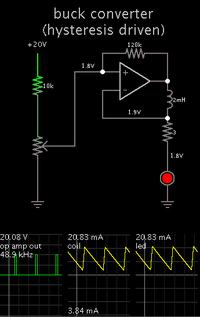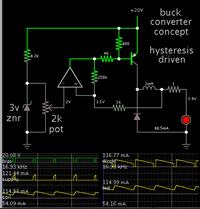T
treez
Guest

Self oscillating Buck LED driver has too many components
Hello,
I have here a simulation (LTspice) of a self oscillating Buck LED driver. It just regulates the LED current by switching ON/OFF its FET when the inductor current hits the requisite peak and trough levels. One comparator acts on the peak of the inductor current, the other, on the trough. (there is a resistive inductor current sensor)
The glue logic that I have is a bit messy, (basically it just allows one comparator to disable the other comparator when it trips, to allow proper operation).
Do you know how I can use say NAND latchs in order to tidy up this circuit?
Ltspice simulation and schematic attached..
Hello,
I have here a simulation (LTspice) of a self oscillating Buck LED driver. It just regulates the LED current by switching ON/OFF its FET when the inductor current hits the requisite peak and trough levels. One comparator acts on the peak of the inductor current, the other, on the trough. (there is a resistive inductor current sensor)
The glue logic that I have is a bit messy, (basically it just allows one comparator to disable the other comparator when it trips, to allow proper operation).
Do you know how I can use say NAND latchs in order to tidy up this circuit?
Ltspice simulation and schematic attached..




